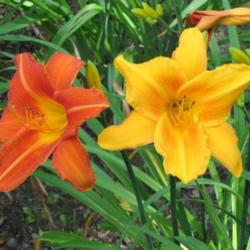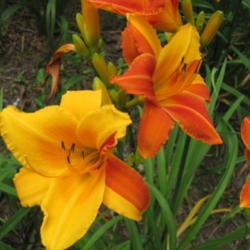A cultivar that is blooming correct, as well as sporting yellow-with-red-edged flower, and producing split-color on other scapes at the same time ... what are the odds?

I'm so glad you continue to document this, Claudia, as I really do think it might be in part a first in the daylily world to be brought forth and shown so superbly. As there can sometimes be strong preconceptions about the limitations of daylily performance ... maybe you might even use cell-phone video capability to take some footage, as it would be difficult for anyone to later say of the possible yellow-sport "was it photoshopped or just seeds that dropped?" That is just how unprecedented a sport would be, and I'd think it would need to be shown by virtue of the scape's connection to the same crown or rhizome root growth of the original cultivar. Ditto for determining if the split-color is a self-pollinated seed-drop or part of the original plant, too. Of course, here at ATP we are lucky to have open-minded, acknowledging, and forward-thinking peeps on board, so my pressing the point of documenting the possible yellow sport, is really just a nod to how important such an event and cultivar might be to the world of daylilies.

First, you may want to be sure to ID the scapes and put in-ground IDs next to each fan, so that as you decide what to do, you'd still be able to identify them even if the flowers drop. And, I hope you'd at least consider getting all of those photos to the ATP database, Claudia, as you can note on each photo, and for the cultivar, what they may represent (perhaps even including a link back to the discussions about it). I noticed there are other ATP members who also have Flasher, and wonder if there is something similar happening in their clones of the cultivar. Perhaps
@nutsfordaylily is waiting on their bloom this year, and could let us know if they see anything similar happen? A sport occurs to any part of any plant (leaf, flower, etc), and has not been shown to be universal to a cultivar's performance in different gardens. **So perhaps the yellow flowers are unique to your fans only, and would be a first and only documented case in daylilies if they are connected to the original plant by crown or rhizome.**
If the yellow flower is confirmed as a sport connected to an original true-to-form fan, and it doesn't revert back to full color in subsequent scapes, I would imagine that you could be the first to register a daylily sport in the history of DL hybridization (as I'd think it should be attributed to whomever owns the sport).
On the other hand, the split-color flowers seem to be more universal and wide-spread in the genetic mix of daylilies, and perhaps would be so in other Flasher fans too, since split-colors have been seen, documented, and when stable, registered quite a lot over the years. Still a very lovely look, even though not so unusual to find. I'd think it would still need to be shown that it is connected to the original plant versus self-pollinated seed that could have fallen to the ground though? Either way, it is always nice to see split or streaked colors in daylilies.
Perhaps
@floota would know how a stable sport, or some complex sport/jumping-gene mutation that's been postulated (if that is separate from what has been shown, for example, in discussion of other split-color daylilies at:
The thread "Oddities" in
Daylilies forum )...
... or a stable split-color, would each be handled for registration if they are shown to be connected to the original plant and not self-pollinated dropped seed? And, my guess is that Dr. Terry McGarty
@terry2, another brilliant ATP contributing member who has written a free book on daylily colors (linked in ATP discussion thread at:
The thread "Hemerocallis Species, Hybrids, and Genetics. Terry McGarty." in
Daylilies forum ), may enjoy seeing your amazing photos, too!
@tink3472 may also have some kind of sporting going on, both in form and color -- this is the only other possible daylily sport we've ever seen being explored before, and we all wait with excitement to hear if she might find if it is from the same crown or rhizomes as the original.
The thread "Unidentified Flowering Oddities" in
Daylilies forum 
Such an apt signature line, Claudia. Many would hesitate to come forward and share news that others have discounted so often, and in some cases for many decades, but you are in a growing number who let nature tell you her own story straight up from the garden. You are quite an inspiration to everyone who goes out to garden and remains open to the myriad potential, and endless gifts, of nature.

"When we come to an edge we come to a frontier that tells us that we are now about to become more than we have been before."
~ Claudia, quoting William Irwin Thompson

